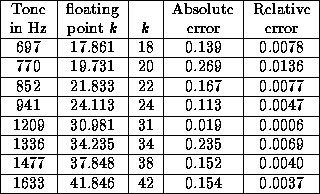Goertzel Algorithm



Next: NDFE Algorithm
Up: Performance Evaluation and Real-Time
Previous: Dual-Tone Multiple Frequencies
The Goertzel algorithm is more efficient than the Fast Fourier Transform
in computing an  -point DFT if less than
-point DFT if less than  DFT coefficients
are required [9].
In DTMF detection, we only need 8 of, for example, 205 DFT coefficients
to detect the first harmonics of the 8 possible tones, and then
apply decision logic to choose the strongest touch tone.
Since DTMF signals do not have second harmonics, we could compute
another 8 DFT coefficients to compute the second harmonics to detect
the presence of speech [3].
DFT coefficients
are required [9].
In DTMF detection, we only need 8 of, for example, 205 DFT coefficients
to detect the first harmonics of the 8 possible tones, and then
apply decision logic to choose the strongest touch tone.
Since DTMF signals do not have second harmonics, we could compute
another 8 DFT coefficients to compute the second harmonics to detect
the presence of speech [3].
The Goertzel algorithm computes the  th DFT coefficient of the
input signal
th DFT coefficient of the
input signal  using a second-order filter
using a second-order filter


where  .
The
.
The  th DFT coefficient is produced after the filter has processed
th DFT coefficient is produced after the filter has processed
 samples:
samples:  .
The key in an implementation is to run
.
The key in an implementation is to run  for
for  samples
and then evaluate
samples
and then evaluate  .
The computation for
.
The computation for  takes one add (
takes one add ( ) and
one multiply-accumulate per sample.
In DTMF detection, we are only concerned with the power of the
) and
one multiply-accumulate per sample.
In DTMF detection, we are only concerned with the power of the
 th coefficient,
th coefficient,  :
:

The value of  must be shorter than the samples in half of a DTMF
signaling interval (
must be shorter than the samples in half of a DTMF
signaling interval ( ), be large enough for good frequency resolution
(
), be large enough for good frequency resolution
( ), and meet the relative error specification 2(a).
We used a conventional value of
), and meet the relative error specification 2(a).
We used a conventional value of  = 205 [10][3] because
it is roughly half of 400 samples.
Decision logic can be added to give a valid DTMF signal if the same two
DTMF tones are detected in a row to add robustness against noise.
= 205 [10][3] because
it is roughly half of 400 samples.
Decision logic can be added to give a valid DTMF signal if the same two
DTMF tones are detected in a row to add robustness against noise.
Table 1: Chosen  values to minimize the error in
values to minimize the error in  .
.

Brian L. Evans, 211-105 Cory Hall, Berkeley, CA 94720-1772
 -point DFT if less than
-point DFT if less than  DFT coefficients
are required [9].
In DTMF detection, we only need 8 of, for example, 205 DFT coefficients
to detect the first harmonics of the 8 possible tones, and then
apply decision logic to choose the strongest touch tone.
Since DTMF signals do not have second harmonics, we could compute
another 8 DFT coefficients to compute the second harmonics to detect
the presence of speech [3].
DFT coefficients
are required [9].
In DTMF detection, we only need 8 of, for example, 205 DFT coefficients
to detect the first harmonics of the 8 possible tones, and then
apply decision logic to choose the strongest touch tone.
Since DTMF signals do not have second harmonics, we could compute
another 8 DFT coefficients to compute the second harmonics to detect
the presence of speech [3].
 th DFT coefficient of the
input signal
th DFT coefficient of the
input signal  using a second-order filter
using a second-order filter


 .
The
.
The  .
The key in an implementation is to run
.
The key in an implementation is to run  for
for  .
The computation for
.
The computation for  ) and
one multiply-accumulate per sample.
In DTMF detection, we are only concerned with the power of the
) and
one multiply-accumulate per sample.
In DTMF detection, we are only concerned with the power of the
 :
:
 ), be large enough for good frequency resolution
(
), be large enough for good frequency resolution
( ), and meet the relative error specification 2(a).
We used a conventional value of
), and meet the relative error specification 2(a).
We used a conventional value of 